74 F. average high for May 30.
88 F. high temperature on May 30, 2011.
.01" of rain predicted today (NAM model). No significant rain expected through Saturday.
+5.3 F. May temperatures in the Twin Cities are running more than 5 degrees above average, to date.

Warmest spring for the USA since 1895 shaping up - details below.
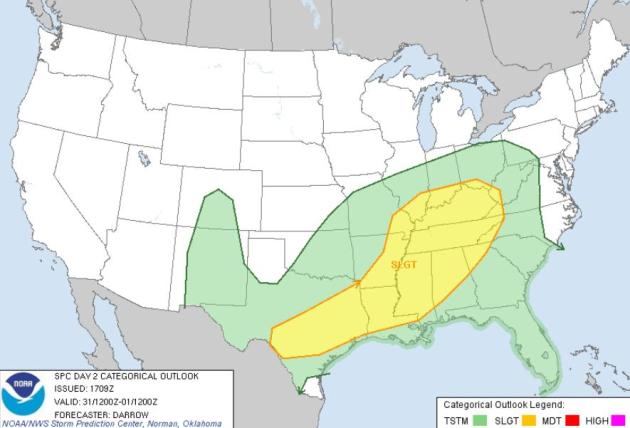
Thursday Severe Risk. Cool, Canadian air pressing southward will spark strong to severe storms later today from Houston to Little Rock, Memphis, Louisville and Atlanta, according to SPC.
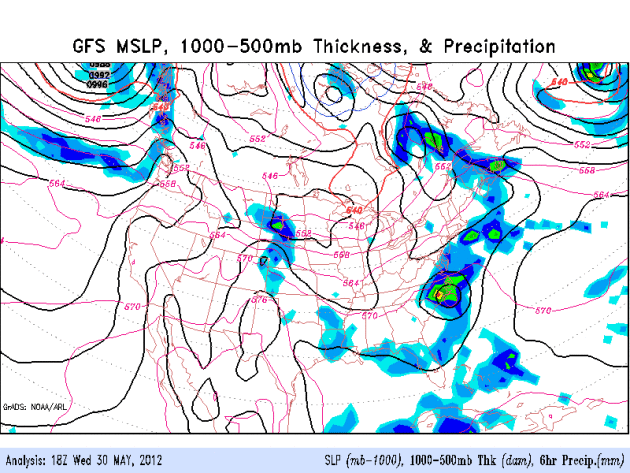
180-Hour Outlook. Here is the raw GFS model data looking into the middle of next week. A cool rain pushes across the Midwest into the Great Lakes today and Friday, while the soggy remains of "Beryl" pinwheel out into the North Atlantic. Warm air pushes north over the weekend, a more summerlike spell returning to much of the USA next week.
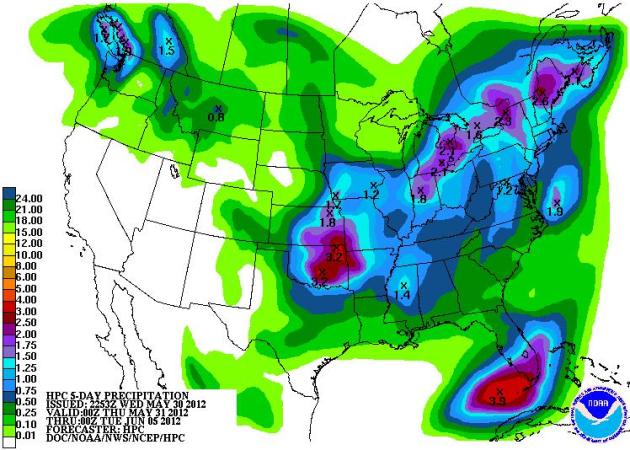
QPF. The 5-day rainfall outlook calls for a continuation of dry weather for the southwest, moderate rain for Seattle, the heaviest rains from Oklahoma City to Detroit, upstate New York and northern New England. South Florida may pick up some 2-4" rainfall amounts, based on NOAA models.
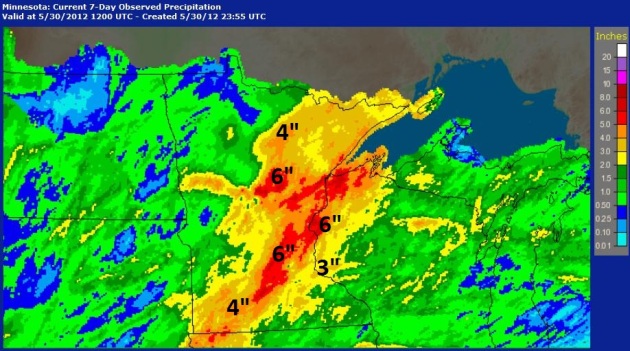
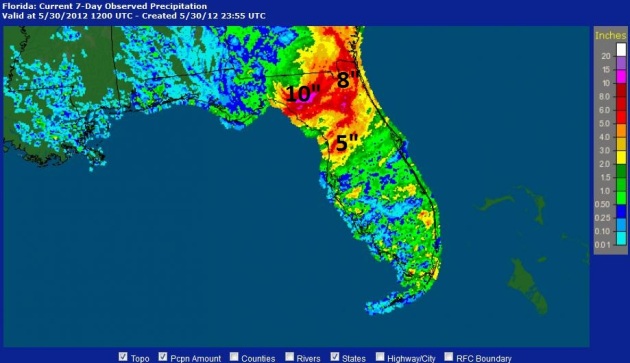



More Summer Heatwaves In Europe: Predictability Of European Summer Heat From Spring And Winter Rainfall. Meteorologists and climatologists talk of "telecommunications" - strange links and odd atmospheric domino effects that leave us scratching our collective heads. Here's an interesting finding from Science Daily: "The prediction, one season ahead, of summer heat waves in Europe remains a challenge. A new study led by a French-Swiss team shows that summer heat in Europe rarely develops after rainy winter and spring seasons over Southern Europe. Conversely dry seasons are either followed by hot or cold summers. The predictability of summer heat is therefore asymmetric. Climate projections indicate a drying of Southern Europe. The study suggests that this asymmetry should create a favorable situation for the development of more summer heat waves with however a modified seasonal predictability from winter and spring rainfall." Photo: NOAA.
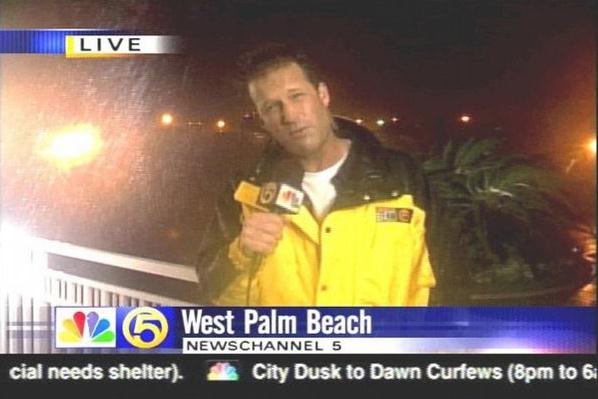

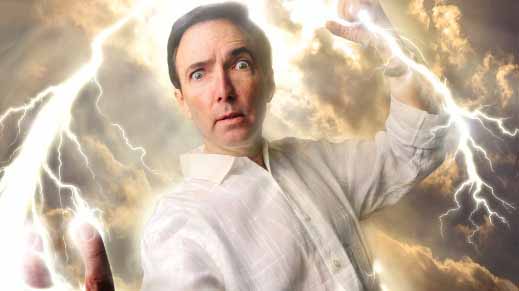
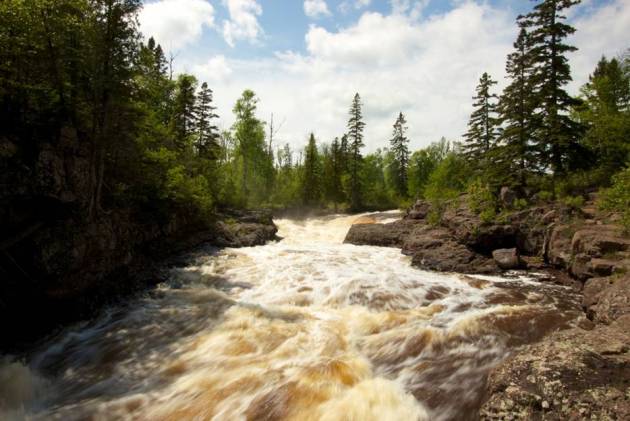
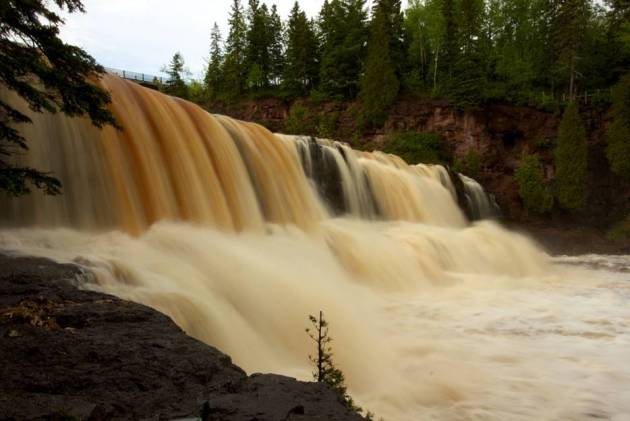
Paul,
"Took these (Monday) on the way back from
Saganaga Lake. First one is of the Temperance River. The others are at
Gooseberry Falls. Was hiking at Temperance last month and it was
nothing like this. Last time I was at Gooseberry was in March and I was
ice climbing. What a difference!!
Lightning question:
We were camped right by the border on Sag Lake
Fri-Mon. Sunday night we had a few bands of T-storms. Nothing very
severe but the lightning was amazing. We were inside the tent so I
couldn't see bolts but there had to have been 50-100 flashes per minute
but rarely was there any thunder. That might be something I'd associate
with heat lightning but it never got above 55 degrees up there (if
that). Any idea what it was? Also, any good references that explain
when the danger is highest for CG lightning with a thunderstorm?"
Thanks!
Steve Burns
Steve- thanks for the great pics (displayed above)
and an interesting questions. You can often see lightning 50-200 miles
away, but thunder is rarely heard from a storm much more than 5-7 miles
away. What some refer to as "heat lightning" is simply lightning from a
distant thunderstorms, sometimes even over the horizon, reflecting off
of haze or high clouds. As a rule of thumb - 25 lightning flashes/minute
or more is a tip-off that a storm may be especially severe, capable of
large hail, even tornadoes. Recent data suggests a sudden drop-off in
lightning strikes right before tornado formation, as the updraft
collapses, bouyant downdrafts interacting with sputtering updrafts to
focus horizontal wind shear about a vertical axis that (sometimes, on
rare occasions) results in tornado formation.
____________________________________________________________________________________
"Where can I buy a good NOAA weather radio? Need one that includes the metro area and Leech Lake area, Can't seem to find it by Google."
Thanks,
Kathy Voss

Kathy - any Best Buy, Target or Radio Shack should have a good selection of NOAA Weather
Radios, priced between $30 and $70. Make sure you purchase one with
"SAME" technology, which allows you to input only the specific county or
counties you're interested in. Every county has a number - you plug in
the number assigned to your county; that way you won't go crazy when
warnings are issued for counties 100 miles away. Midland makes a solid
NOAA Weather Radio, btw. I've said it before, I'll say it again: NOAA
Weather Radio is the cheapest, most effective form of life insurance you
can buy.
_____________________________________________________________________________________
Paul,"This isn't a question but I wanted to tell you how much I appreciated your column from Memorial Day. It was interesting to read about your family history and especially about your son's graduation from the Naval Academy today: CONGRATULATIONS to all of your family! It was 8 years ago today that my youngest son (also Paul) graduated from the US Military Academy at West Point, so I know how much pride you and your family are feeling now. Best wishes to you son as he is commissioned and God speed as he continues his life in the service of our country. My son is currently in his 4th overseas tour, and his second one to Afghanistan where he is serving as a Company Commander in a Stryker battalion, based out of Fort Lewis in WA. Thanks for all of your interesting columns!"
Mary Tanghe
Mary - thanks for the nice note; appreciate you reading the weather column, and please send my thanks to your son, Paul, the very definition of a modern-day American Hero. We don't take his service for granted. Our prayers are with Paul and his remarkable family.
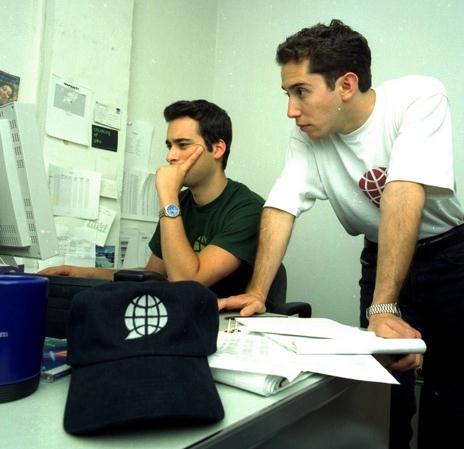

Photo credit above: ceoworld.biz.

The Facebook Illusion. Hey, I have nothing against FB or Mr. Zuckerburg; it's the classic (Harvard) rags-to-riches story, a subtle yet blunt reminder that anyone, in theory, can still get (very) rich in the good 'ol USA. Will we still all be using FB in 5 years? Probably. Is the company going to have a tough time making the dollars (especially mobile advertising dollars) match the hype? Not sure - they have their work cut out for them, but I'm not sure I'd bet against them right now. Here's an excerpt of a New York Times Op-Ed that may be of interest: "...I will confess to taking a certain amount of dyspeptic pleasure from Facebook’s hard landing, which had Bloomberg Businessweek declaring the I.P.O. “the biggest flop of the decade” after five days of trading. Of all the major hubs of Internet-era excitement, Mark Zuckerberg’s social networking site has always struck me as one of the most noxious, dependent for its success on the darker aspects of online life: the zeal for constant self-fashioning and self-promotion, the pursuit of virtual forms of “community” and “friendship” that bear only a passing resemblance to the genuine article, and the relentless diminution of the private sphere in the quest for advertising dollars."
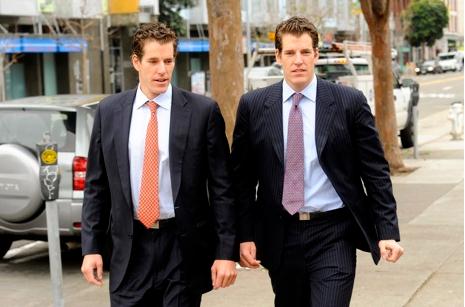



Hints of Autumn. Free air conditioning for everyone! In spite of sunny peeks temperatures were a good 10+ degrees cooler than average yesterday, ranging from a brisk 57 at Alexandria to 60 St. Cloud, and 62 in the Twin Cities. .03" of rain had fallen at Redwood Falls as of 7 pm Wednesday.
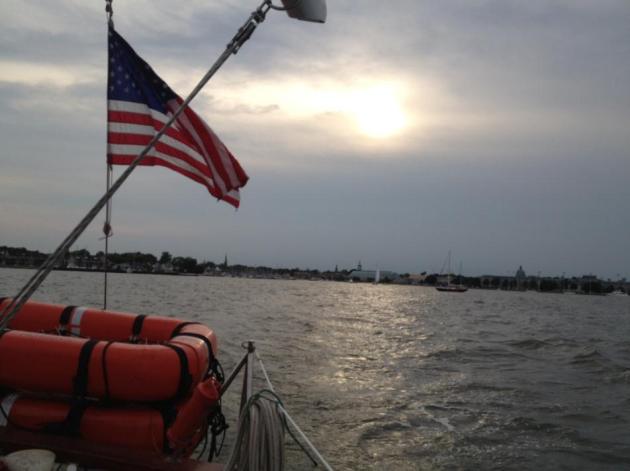
Paul's Conservation Minnesota Outlook for the Twin Cities and all of Minnesota:
TODAY: Patchy clouds, shower far south? Unseasonably cool. Winds: NE 10. High: 65
THURSDAY NIGHT: Partial clearing. Low: 51
FRIDAY: Partly sunny, late thunder possible. High: 73
SATURDAY: Intervals of sun, lukewarm. Winds: W 10. High: 74
SUNDAY: Warmer, better day for the lake. Few T-Storm north. Winds: SW 10. Low: 58. High: 81
MONDAY: Damp start, then warm sun. Low: 62. High: 82
TUESDAY: Plenty of sun, feels like summer again. Low: 64. High: 83
WEDNESDAY: Mix of clouds and sun, probably dry. Low: 63. High: 81

A Quiet Week
I'm sure enjoying the last day of September! The
summer went by quick, didn't it? I know, not funny.
I'm waiting
for Garrison Keillor's creative crew to do a sketch about a mythical
Lake Wobegon family unable and unwilling to come out of their basement. One too many tornado warnings.
Weather phobia is a real concern, especially for kids. Tornado trauma can inspire them to grow up to become
meteorologists, in fact most TV forecasters were inspired by a storm, a
flood or blizzard. No one with full command of their faculties sets out
to guess the weather on a daily basis.
Breaking news:
ClimateClimate reports we're about to crush the record for warmest
spring, nationwide, since 1895. So why is my furnace rumbling away this
morning? Enjoy the cool front; this push of Canadian air will cause
storms to detour south of Minnesota today. We warm up into the weekend;
only an isolated shower Friday, maybe a T-storm up north by Sunday when
highs top 80. No, this weekend won't be nearly as soggy as last. Dry, summerlike 80s return next week.
Oh,
about that imaginary, timid, storm-rattled family refusing to come out
of the basement? Check the radon levels. That would be just my luck.
* photo credit here.
Climate Stories...
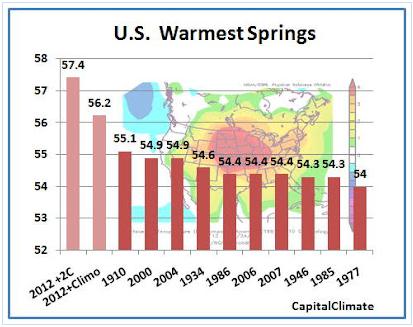

Sunscreen In The Sky? Reflective Particles May Combat Warming. Maybe it'll come to this - spraying chemicals into the atmosphere to counteract the influence of (warming) greenhouse gases. More and more credence is being given to "geo-engineering". Dumping more chemicals into the sky - what can possibly go wrong? Here's a more upbeat assessment from National Geographic: "Spritzing a sunscreen ingredient into the stratosphere could help counteract the effects of global warming, according to scientists behind an ambitious new geoengineering project. The plan involves using high-altitude balloons to disperse millions of tons of titanium dioxide—a nontoxic chemical found in sunscreen as well as in paints, inks, and even food. Once in the atmosphere, the particles would spread around the planet and reflect some of the sun's rays back into space. About three million tons of titanium dioxide—spread into a layer around a millionth of a millimeter thick—would be enough to offset the warming effects caused by a doubling of today's atmospheric carbon dioxide levels, according to project leader and chemical engineer Peter Davidson."

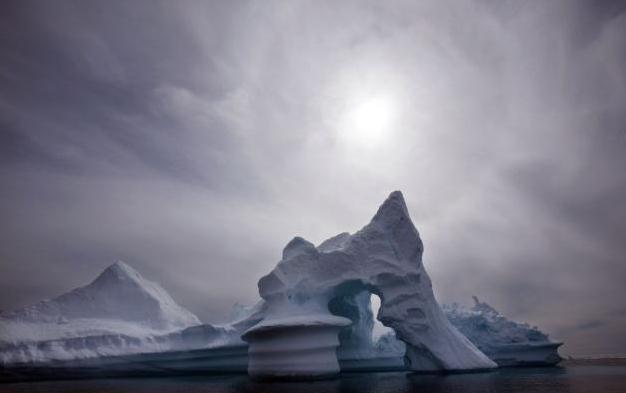

Can Market Forces Really Be Employed To Address Climate Change? Here's a story from The Huffington Post: "Debate continues in the United States, Europe and throughout the world about whether the forces of the marketplace can be harnessed in the interest of environmental protection, in particular, to address the threat of global climate change. In an essay that appears in the Spring 2012 issue of Daedalus, the journal of the American Academy of Arts and Sciences, my colleague, Joseph Aldy, and I take on this question. In the article — "Using the Market to Address Climate Change: Insights from Theory & Experience" — we investigate the technical, economic, and political feasibility of market-based climate policies, and examine alternative designs of carbon taxes, cap-and-trade, and clean energy standards."


Photo credit above: "The cities of the Harappan civilization were well constructed sophisticated affairs with a surprising number of modern conveniences such as plumbing."
No comments:
Post a Comment